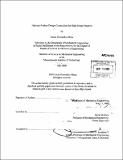| dc.contributor.advisor | David Wallace. | en_US |
| dc.contributor.author | Hernandez-Mena, Lucas | en_US |
| dc.contributor.other | Massachusetts Institute of Technology. Dept. of Mechanical Engineering. | en_US |
| dc.date.accessioned | 2010-04-28T16:57:37Z | |
| dc.date.available | 2010-04-28T16:57:37Z | |
| dc.date.issued | 2009 | en_US |
| dc.identifier.uri | http://hdl.handle.net/1721.1/54533 | |
| dc.description | Thesis (S.B.)--Massachusetts Institute of Technology, Dept. of Mechanical Engineering, 2009. | en_US |
| dc.description | Cataloged from PDF version of thesis. | en_US |
| dc.description | Includes bibliographical references (p. 26). | en_US |
| dc.description.abstract | Sir Ken Robinson said, "We don't grow into creativity, we grow out of it or rather we're educated out of it."' Throughout my education I have found this statement to be true especially in it's relation to high school education in America. This lack of creativity-based education is the inspiration for this thesis work. As a high school student I was able to participate in a few robotics competitions, such as FIRST Robotics Competition, that enabled me to begin thinking creatively about problems. These competitions were focused on allowing students to gain engineering experience and inspiring them to pursue a degree in a science or technology field. However, the competitions tended to primarily attract students who are already interested in these fields. This thesis will propose and provide motivation for an Internet-centric, national product design competition for high school students that will teach and inspire the use of creativity for a wide range of students that have interests in many different fields. This document begins with highlighting and outlining the main competitions, programs, and classes that have been drawn on for the creation of this competition. Then, the main motivation and goals of the competition are outlined. Lastly the structure of the competition and the online community is described. The competition proposed in this thesis is perhaps a utopian ideal structure that requires further development and consideration before it can be implemented in the high school setting. Some future development includes surveying high school teachers on the practicality of such a competition in relation to their personal experiences with the interest level and capabilities of high school students. | en_US |
| dc.description.abstract | (cont.) Also a large a part of the future work would include the development and testing of the online community as a portal for high school students to learn and share about product design. Lastly, future work will involve an intensive analysis of the financial requirements incorporated with the implementation of a competition of this nature. | en_US |
| dc.description.statementofresponsibility | by Lucas Hernandez-Mena. | en_US |
| dc.format.extent | 26 p. | en_US |
| dc.language.iso | eng | en_US |
| dc.publisher | Massachusetts Institute of Technology | en_US |
| dc.rights | M.I.T. theses are protected by
copyright. They may be viewed from this source for any purpose, but
reproduction or distribution in any format is prohibited without written
permission. See provided URL for inquiries about permission. | en_US |
| dc.rights.uri | http://dspace.mit.edu/handle/1721.1/7582 | en_US |
| dc.subject | Mechanical Engineering. | en_US |
| dc.title | National product design competition for high school students | en_US |
| dc.type | Thesis | en_US |
| dc.description.degree | S.B. | en_US |
| dc.contributor.department | Massachusetts Institute of Technology. Department of Mechanical Engineering | |
| dc.identifier.oclc | 565949965 | en_US |
